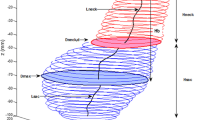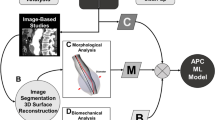Abstract
The objective of this work was to perform image-based classification of abdominal aortic aneurysms (AAA) based on their demographic, geometric, and biomechanical attributes. We retrospectively reviewed existing demographics and abdominal computed tomography angiography images of 100 asymptomatic and 50 symptomatic AAA patients who received an elective or emergent repair, respectively, within 1–6 months of their last follow up. An in-house script developed within the MATLAB computational platform was used to segment the clinical images, calculate 53 descriptors of AAA geometry, and generate volume meshes suitable for finite element analysis (FEA). Using a third party FEA solver, four biomechanical markers were calculated from the wall stress distributions. Eight machine learning algorithms (MLA) were used to develop classification models based on the discriminatory potential of the demographic, geometric, and biomechanical variables. The overall classification performance of the algorithms was assessed by the accuracy, area under the receiver operating characteristic curve (AUC), sensitivity, specificity, and precision of their predictions. The generalized additive model (GAM) was found to have the highest accuracy (87%), AUC (89%), and sensitivity (78%), and the third highest specificity (92%), in classifying the individual AAA as either asymptomatic or symptomatic. The k-nearest neighbor classifier yielded the highest specificity (96%). GAM used seven markers (six geometric and one biomechanical) to develop the classifier. The maximum transverse dimension, the average wall thickness at the maximum diameter, and the spatially averaged wall stress were found to be the most influential markers in the classification analysis. A second classification analysis revealed that using maximum diameter alone results in a lower accuracy (79%) than using GAM with seven geometric and biomechanical markers. We infer from these results that biomechanical and geometric measures by themselves are not sufficient to discriminate adequately between population samples of asymptomatic and symptomatic AAA, whereas MLA offer a statistical approach to stratification of rupture risk by combining demographic, geometric, and biomechanical attributes of patient-specific AAA.





Similar content being viewed by others
References
Brown, P. M., D. T. Zelt, and B. Sobolev. The risk of rupture in untreated aneurysms: the impact of size, gender, and expansion rate. J. Vasc. Surg. 37(2):280–284, 2003.
Chaikof, E. L., R. L. Dalman, M. K. Eskandari, B. M. Jackson, W. A. Lee, M. A. Mansour, T. M. Mastracci, M. Mell, M. H. Murad, L. L. Nguyen, G. S. Oderich, M. S. Patel, M. L. Schermerhorn, and B. W. Starnes. The Society for Vascular Surgery practice guidelines on the care of patients with an abdominal aortic aneurysm. J. Vasc. Surg. 67(1):2–77, 2018.
Cui, S. S., L. K. Zhao, Y. M. Wang, Q. Dong, J. X. Ma, Y. Wang, W. Zhao, and X. Ma. Using Naive Bayes classifier to predict osteonecrosis of the femoral head with cannulated screw fixation. Injury. 49(10):1865–1870, 2018.
Darling, R. C., C. R. Messina, D. C. Brewster, and L. W. Ottinger. Autopsy study of unoperated abdominal aortic aneurysms. The case for early resection. Circulation. 56(3 Suppl):II161–II164, 1977.
Endo, A., A. Shiraishi, K. Fushimi, K. Murata, and Y. Otomo. Outcomes of patients receiving a massive transfusion for major trauma. Br. J. Surg. 105(11):1426–1434, 2018.
Farag, A. A., A. Ali, and S. Elshazly. Feature fusion for lung nodule classification. Int. J. CARS. 12(10):1809–1818, 2017.
Fillinger, M. F., M. L. Raghavan, S. P. Marra, J. L. Cronenwett, and F. E. Kennedy. In vivo analysis of mechanical wall stress and abdominal aortic aneurysm rupture risk. J. Vasc. Surg. 36(3):589–597, 2002.
Gasser, T. C. Biomechanical rupture risk assessment: a consistent and objective decision-making tool for abdominal aortic aneurysm patients. Aorta. 4(2):42–60, 2016.
Jeong, C., J. H. Min, and M. S. Kim. A tuning method for the architecture of neural network models incorporating GAM and GA as applied to bankruptcy prediction. Expert Syst. Appl. 39(3):3650–3658, 2012.
Larsson, E., F. Labruto, T. C. Gasser, J. Swedenborg, and R. Hultgren. Analysis of aortic wall stress and rupture risk in patients with abdominal aortic aneurysm with a gender perspective. J. Vasc. Surg. 54(2):295–299, 2011.
Lau, L., Y. Kankanige, B. Rubinstein, R. Jones, C. Christophi, V. Muralidharan, and J. Bailey. Machine-learning algorithms predict graft failure after liver transplantation. Transplantation. 101(4):E125–E132, 2017.
Leathwick, J. R., J. Elith, and T. Hastie. Comparative performance of generalized additive models and multivariate adaptive regression splines for statistical modelling of species distributions. Ecol. Model. 199(2):188–196, 2006.
Lee, K., J. Zhu, J. Shum, Y. Zhang, S. C. Muluk, A. Chandra, M. K. Eskandari, and E. A. Finol. Surface curvature as a classifier of abdominal aortic aneurysms: a comparative analysis. Ann. Biomed. Eng. 41:562–576, 2013.
Leemans, E. L., T. P. Willems, C. H. Slump, M. J. van der Laan, and C. J. Zeebregts. Additional value of biomechanical indices based on CTA for rupture risk assessment of abdominal aortic aneurysms. PLoS ONE. 13(8):e0202672, 2018.
Maier, A., M. Gee, C. Reeps, J. Pongratz, H.-H. Eckstein, and W. Wall. A comparison of diameter, wall stress, and rupture potential index for abdominal aortic aneurysm rupture risk prediction. Ann. Biomed. Eng. 38:3124–3134, 2010.
Martufi, G., E. S. Di Martino, C. H. Amon, S. C. Muluk, and E. A. Finol. Three-dimensional geometrical characterization of abdominal aortic aneurysms: image-based wall thickness distribution. J. Biomech. Eng. 131(6):061015, 2009.
Mastracci, T. M., L. Garrido-Olivares, C. S. Cinà, and C. M. Clase. Endovascular repair of ruptured abdominal aortic aneurysms: a systematic review and meta-analysis. J. Vasc. Surg. 47(1):214–221, 2008.
Min, K. W., D. H. Kim, B. K. Son, E. K. Kim, S. B. Ahn, S. H. Kim, Y. J. Jo, Y. S. Park, J. Seo, Y. H. Oh, S. Oh, H. Y. Kim, M. J. Kwon, S. K. Min, H. R. Park, J. Y. Choe, J. Y. Jeon, H. I. Ha, and J. W. Lee. Invasion depth measured in millimeters is a predictor of survival in patients with distal bile duct cancer: decision tree approach. World J. Surg. 41(1):232–240, 2017.
Mower, W. R., L. J. Baraff, and J. Sneyd. Stress distributions in vascular aneurysms: factors affecting risk of aneurysm rupture. J. Surg. Res. 55(2):155–161, 1993.
Parikh, S. A., R. Gomez, M. Thirugnanasambandam, S. S. Chauhan, V. De Oliveira, S. C. Muluk, M. K. Eskandari, and E. A. Finol. Decision tree based classification of abdominal aortic aneurysms using geometry quantification measures. Ann. Biomed. Eng. 46:2135–2147, 2018.
Polzer, S., and T. C. Gasser. Biomechanical rupture risk assessment of abdominal aortic aneurysms based on a novel probabilistic rupture risk index. J. R. Soc. Interface. 12(113):20150852, 2015.
Raghavan, M. L., and D. A. Vorp. Toward a biomechanical tool to evaluate rupture potential of abdominal aortic aneurysm: identification of a finite strain constitutive model and evaluation of its applicability. J. Biomech. 33:475–482, 2000.
Raut, S. S., P. Liu, and E. A. Finol. An approach for patient-specific multi-domain vascular mesh generation featuring spatially varying wall thickness modeling. J. Biomech. 48(10):1972–1981, 2015.
Shum, J., E. S. Di Martino, A. Goldhammer, D. H. Goldman, L. C. Acker, G. Patel, J. H. Ng, G. Martufi, and E. A. Finol. Semiautomatic vessel wall detection and quantification of wall thickness in computed tomography images of human abdominal aortic aneurysms. Med. Phys. 37(2):638–648, 2010.
Shum, J., G. Martufi, E. S. Di Martino, C. B. Washington, J. Grisafi, S. C. Muluk, and E. A. Finol. Quantitative assessment of abdominal aortic aneurysm geometry. Ann. Biomed. Eng. 39:277–286, 2011.
Tang, A., C. Kauffmann, S. Tremblay-Paquet, S. Elkouri, O. Steinmetz, F. Morin-Roy, L. Cloutier-Gill, and G. Soulez. Morphologic evaluation of ruptured and symptomatic abdominal aortic aneurysm by three-dimensional modeling. J. Vasc. Surg. 59(4):894–902, 2014.
Wijeysundera, D. N., K. Karkouti, J. Y. Dupuis, V. Rao, C. T. Chan, J. T. Granton, and W. S. Beattie. Derivation and validation of a simplified predictive index for renal replacement therapy after cardiac surgery. JAMA. 297(16):1801–1809, 2007.
Xenos, M., S. H. Rambhia, Y. Alemu, S. Einav, N. Labropoulos, A. Tassiopoulos, J. J. Ricotta, and D. Bluestein. Patient-based abdominal aortic aneurysm rupture risk prediction with fluid structure interaction modeling. Ann. Biomed. Eng. 38(11):3323–3337, 2010.
Zheng, S. F., and W. X. Liu. An experimental comparison of gene selection by Lasso and Dantzig selector for cancer classification. Comput. Biol. Med. 41(11):1033–1040, 2011.
Acknowledgments
Research funding was provided in part by National Institutes of Health Award No. R01HL121293. The content is solely the responsibility of the authors and does not necessarily represent the official views of the National Institutes of Health. The use of ANSYS Ensight is gratefully acknowledged through an educational licensing agreement with Ansys, Inc.
Conflict of interest
The authors have no conflicts of interest to disclose.
Author information
Authors and Affiliations
Corresponding author
Additional information
Associate Editor Estefanía Peña oversaw the review of this article.
Publisher's Note
Springer Nature remains neutral with regard to jurisdictional claims in published maps and institutional affiliations.
Electronic supplementary material
Below is the link to the electronic supplementary material.
Rights and permissions
About this article
Cite this article
Rengarajan, B., Wu, W., Wiedner, C. et al. A Comparative Classification Analysis of Abdominal Aortic Aneurysms by Machine Learning Algorithms. Ann Biomed Eng 48, 1419–1429 (2020). https://doi.org/10.1007/s10439-020-02461-9
Received:
Accepted:
Published:
Issue Date:
DOI: https://doi.org/10.1007/s10439-020-02461-9




